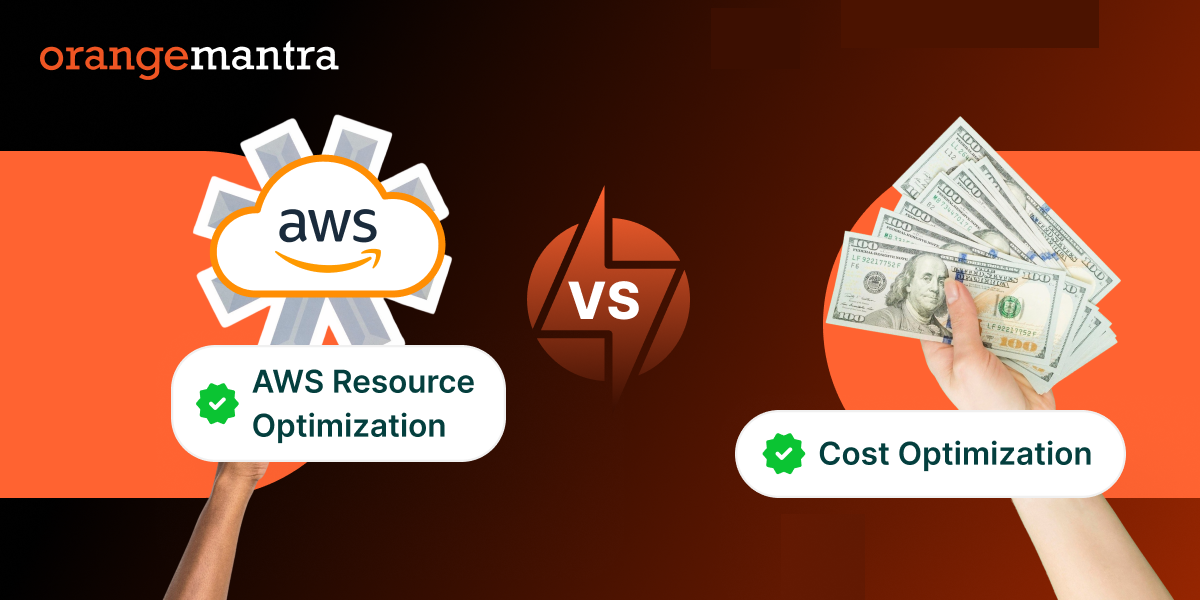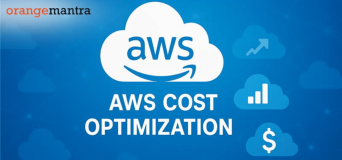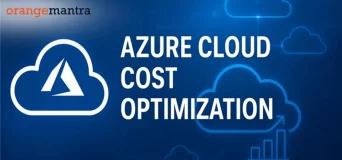
Here’s what you will learn:
It is now possible to have cloud computing as the core of IT infrastructure, and the dependence on platforms such as AWS increases. But this has its challenge, whereby the cloud administrators are tasked with managing the clouds while at the same time ensuring that they do not spend a lot of money on the expenses of doing this.
Sometimes, they are termed as resource optimization and cost optimization. Even though these two concepts characterize the general concept and are interconnected with each other, they exist to perform different objectives and are discussed with the help of different perspectives.
It is essential for tech executives, cloud professionals, and developers seeking to achieve the right balance of performance with affordable costs. AWS certified partners like OrangeMantra offer you the best AWS resource optimization and cost optimization services.
Table of Contents
What is AWS Resource Optimization?
AWS resource optimization is centered on that necessary step to ensure infrastructure has the right type and size of resources to deliver the workload in the best possible way. Computer and storage resources, databases and networking also come under this category as they need to be employed in the most optimum manner.
For instance, if an EC2 instance consistently has 20% CPU utilization, then it suggests over-provisioning. Apart from enhancing efficiency in the management of the situation, it also optimizes the utilization of resources that can be assigned to other tasks. In the same way, the selection of software (like S3 Standard and S3 IA) provides an opportunity to improve operational productivity.
Key activities include:
- Right-sizing compute instances
- Optimizing storage classes and volumes
- Scaling databases based on usage
- Removing idle or underutilized resources
What is AWS Cost Optimization?
Cost optimization, on the other hand, is all about avoiding costs incurred on running applications in AWS. Hire AWS developers team that helps you keep a continuous check on the use made of a given product and its costs in order to determine where one can save.
Whereas Resource optimization is commonly identified with cost reduction, cost optimization involves systematic management of financial resources. For example, it can greatly reduce the prices of Reserved Instances or Savings Plans for steady-running tasks.
Common techniques include:
- Turning off unused resources (e.g., dev/test environments during off-hours)
- Using Savings Plans or Reserved Instances
- Setting budgets and alerts to prevent overspending
- Leveraging AWS Free Tier and spot instances
Also Read: AWS Cost Optimization: The Complete Guide for 2025
How do AWS Resource Optimization and AWS cost optimization services work together?
Cost optimization measures can work together with resource optimization because they share a common goal. Optimizing the sizes of EC2 instances (resource decision) leads to reduced monthly AWS expenses (cost outcome). Organizations that focus on cost reduction will discover resource areas that display either excessive provision of resources or underutilized capacity.
Resource optimization functions the same as maintaining a car because it both gives your engine performance tuning and reduces fuel wastage, which matches cost optimization practices.
When you optimize your engine properly, you will automatically need less fuel, and a cost-effective driving style helps your engine stay healthy. The application of these two approaches achieves their best outcome when they operate together.
Different Supporting Tools and Services exist for implementation
AWS Resource Optimization Tools:
AWS Compute Optimizer: Provides recommendations for right-sizing EC2, Lambda, and Auto Scaling groups.
AWS CloudWatch: Monitors resource utilization metrics (CPU, memory, disk IO).
AWS Auto Scaling uses real-time demand metrics to regulate the resources automatically.
AWS Cost Optimization Tools:
AWS Cost Explorer helps view usage information and detect the main sources of expenses.
The AWS Budgets function enables users to create specific financial limitations that trigger notification alerts upon exceeding budgetary values.
Through the AWS Pricing Calculator, users can predict the expenses associated with their planned use of AWS services.
Businesses can lower their expenses through Savings Plans/Reserved Instances by opting for long-term rate commitments.
The selection of proper tools for each application serves to optimize the execution of both optimization strategies.
Common Mistakes to Avoid While Dealing with Resource and Cost Optimization
Many organizations make the error of providing excessive compute and storage resources, which results in higher expenses combined with resources being unused.
Excess capabilities of EC2 instances, together with unclaimed EBS storage volumes and stalled load balancers, generate avoidable costs for Amazon customers.
Reducing costs exclusively without consideration of potential performance impact might result in service interruptions.
Proper resource tagging remains essential because untagged resources become impossible to track and assign costs in environments with extensive resource use.
Humans receive less efficiency from manual monitoring, along with inefficient scaling processes that may contain human errors.
Best Practices for a Balanced Approach
A combination of cost and resource efficiency can be achieved through:
Regular audits must evaluate what both cost and resource usage represent at least once every month or quarter.
Tagging resources through a systematic approach allows organizations to observe and control their resources at the department and project or environment levels.
Automation can help the organization by enabling scheduled EC2 operations and auto-scaling policies, and Lambda scripts for clean-up tasks.
Real-time monitoring happens through the utilization tracking feature available in the CloudWatch dashboard.
Decision-makers should educate their teams about FinOps principles for operational and development departments to assume financial responsibility.
Concluding Thoughts
AWS resource optimization serves as an identical operation to cost optimization. Having an efficient cloud infrastructure depends on resource optimization, while AWS cost optimization services give you maximum return on investment. Combining strategic resource optimization and cost reduction strategies leads to better performance levels while guaranteeing ongoing savings to businesses.
Your cloud strategy refinement process should begin by mastering resource management, followed by financial tool application, and deploying AWS services to achieve optimal results.
The result? AWS operates smoothly and stays budget-friendly because of its efficiently managed operations.




